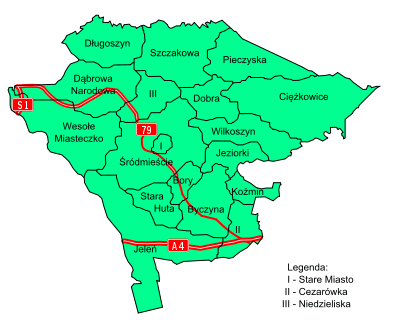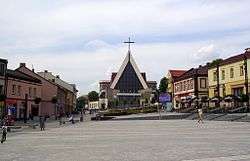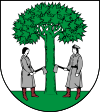Jaworzno
| Jaworzno | |||
|---|---|---|---|
|
Main Square in Jaworzno | |||
| |||
|
Motto: Jaworzno - źródło energii. Jaworzno - the source of energy. | |||
 Jaworzno | |||
| Coordinates: 50°8′N 19°16′E / 50.133°N 19.267°E | |||
| Country | Poland | ||
| Voivodeship | Silesian | ||
| County | city county | ||
| Established | 1229 | ||
| Town rights | 1901 | ||
| Government | |||
| • Mayor | Paweł Silbert | ||
| Area | |||
| • City | 152.2 km2 (58.8 sq mi) | ||
| Population (2008) | |||
| • City | 94,580 | ||
| • Density | 620/km2 (1,600/sq mi) | ||
| • Urban | 2,746,000 | ||
| • Metro | 4,620,624 | ||
| Time zone | CET (UTC+1) | ||
| • Summer (DST) | CEST (UTC+2) | ||
| Postal code | 43-600 to 43-618 | ||
| Area code(s) | +48 32 | ||
| Car plates | SJ | ||
| Website | http://www.jaworzno.pl/ | ||
Jaworzno [jaˈvɔʐnɔ] is a city in southern Poland, near Katowice. It lies in the Silesian Highlands, on the Przemsza river (a tributary of the Vistula). Jaworzno belongs to the historic province of Lesser Poland. The city is situated in the Silesian Voivodeship since its formation in 1999, previously (1975 - 1999) it was in Katowice Voivodeship. Jaworzno is one of the cities of the 2,7 million conurbation - Katowice urban area and within a greater Silesian metropolitan area populated by about 5,294,000 people.[1] The population of the city is 95,520 (2008).[2]
Geography
Location
The municipality is situated a short distance to the north-east of Junction 41 on the A4 Highway. It lies in the Silesian Highlands, in the historical region of Lesser Poland, and since its foundation until 1975, it was administratively tied with Lesser Poland's capital, Kraków. Until 1795, it belonged to Kraków Voivodeship, then, together with Kraków, was seized by the Habsburg Empire in the Partitions of Poland. In 1815 - 1846 it belonged to the Free City of Kraków, which was annexed by Austria and merged with Kingdom of Galicia and Lodomeria. In 1918 Jaworzno returned to Poland. The name of the city comes from the jawor trees (sycamore maple), which in the past were abundant in this area.
Administrative position
Jaworzno was placed into the Silesian Voivodeship (province) effective January 1, 1999 under the Local Government Reorganization Act. Previously, it was attached to the Katowice Voivodeship (1975–1998) and before that to the Kraków Voivodeship. Jaworzno lies in the east of the largest metropolis in Poland and is one of the largest in the European Union, numbering about 3,5 million. This urban expansion bloomed in the 19th century thanks to the rapid development of the mining and metallurgical industries. In the year 2006 Jaworzno and 14 neighboring cities formed the multimunicipal structure, the Upper Silesian Metropolitan Union. Its population is 2 million and its area is 1,304 square kilometres (503 sq mi).
Climate
The climate of the area is continental humid. The annual average temperature is 8 °C (46 °F) (January average −1.7 °C (28.9 °F) and July average 17.7 °C (63.9 °F) °C). Yearly rainfall averages at 750 mm (29.5 in), the most rainy month being July. The area's characteristic weak winds blow at about 2 m/s from the west (Moravian Gate).
Transport
- Routes
Jaworzno is located at the intersection of a number of road routes such as: A4 motorway (part of European route E40) S1 expressway (part of European route E75) Gdańsk - Cieszyn, national road No. 79 Warsaw - Bytom, provincial road No. 903 Jaworzno 79 - Jaworzno 4
- Public transport
Public transport is provided by PKM Jaworzno (Przedsiębiorstwo Komunikacji Miejskiej w Jaworznie - public transport company in Jaworzno) not belonging to the KZK GOP. PKM Jaworzno was one of the first public transport companies in Poland which introduced the magnetic card called Jaworznicka Karta miejska (Jaworzno Urban Card) instead of paper tickets. Currently PKM Jaworzno is one of the most modern public transport companies in Poland
Districts and housing estates

- Bory
- Stara Huta
- Byczyna
- Cezarówka
- Ciężkowice
- Dąbrowa Narodowa
- Długoszyn
- Dobra
- Gigant
- Góra Piasku
- Jeleń
- Jeziorki
- Koźmin
- Niedzieliska
- Pieczyska
- Siłownia
- Podwale
- Stare Miasto (Old City)
- Szczakowa
- Śródmieście (Downtown)
- Wilkoszyn
- Wysoki Brzeg
- Osiedle Stałe
- Osiedle Awaryjne
- Osiedle Cegielniana
- Osiedle Chrząstówka
- Osiedle Energetyków
- Osiedle Gagarina
- Osiedle Górnicze
- Osiedle Kościuszki
- Osiedle Warpie
- Osiedle Leopold
- Osiedle Łubowiec
- Osiedle Pańska Góra
- Osiedle Podłęże
- Osiedle Skałka
- Osiedle Pszczelnik
- Osiedle Sobieski
History
In the Middle Ages, a gord was established on the Grodzisko hill, traces of which can still be found. First known mention of Jaworzno comes from the year 1229, and in 1335, a parish church of St. Wojciech existed here. Jaworzno remained a small village, located in western Lesser Poland, near much larger and more important town of Chrzanow. Since 1179, the nearby Przemsza river marked the border between Lesser Poland and Silesia. It also remained a state border of Poland until 1922. The area of Jaworzno was originally under the rule of the bishops of Kraków. After Austria seized Silesia at the end of the 17th century, several coal mines were developed near Jaworzno. In the 18th century, deposits of silver, lead, iron and zinc were found here. In 1767, first coal mine in the Polish-Lithuanian Commonwealth was opened in Szczakowa.
After the Partitions of Poland Jaworzno belonged to the Habsburg Empire. In 1809 - 1815 it was part of the Duchy of Warsaw, and in 1815-1846, it belonged to the Free City of Krakow, which in 1846 was annexed by the Austrian Empire. Jaworzno remained in Austrian Galicia until November 1918. In the 19th century, the village became famous for the so-called Three Emperors' Corner, where borders of three powers met (German Empire, Russian Empire and Austria-Hungary). In 1847, Jaworzno’s district of Szczakowa received first rail connection, on a line from Prussian Upper Silesia to Kraków. The village became one of centers of industrialization. A power plant was opened in 1898, and Jaworzno’s coal mines extracted 84% of Galician coal. Several new factories were established here in the late 19th and early 20th century. As a result, on September 21, 1901, Emperor Franz Joseph I granted town charter to Jaworzno.
In the Second Polish Republic, Jaworzno belonged to Krakow Voivodeship, in which it also remained after the war, until 1975. During the Second World War SS-Lager Dachsgrube, a branch of the German concentration camp of Auschwitz, was established there. This was converted into Central Labour Camp Jaworzno after the war. It was also a location of several POW camps for the Western Allies. In the People's Republic of Poland Jaworzno developed as an important center of industry. Its population quickly grew, when thousands of migrants came here in search of work at coal mines, power plants and other factories. Furthermore, several villages were annexed by Jaworzno. As a result, Jaworzno’s area reaches 152 square kilometres (59 sq mi). In 1975 the city became part of Katowice Voivodeship. Despite the fact that most towns of pre-1975 Chrzanow County returned to Lesser Poland, Jaworzno was attached to the Silesian Voivodeship (1999).
Environment
Greens, forests, and undeveloped land constitute 60 percent of the town's area. Jaworzno has environmentally valuable areas which as a group present a diversity of landscapes and vegetation as well as a richness of flora and fauna. These include the Dolina Zabnika nature reserve, the Dobra Wilkoszyn landscape protection area, the Sasanka natural surface monument, Grodzisko hill, and Sosina lake. Within Jaworzno's boundaries there are 41 plant species under strict protection and 11 under partial protection.
Media
- Online News
- Jaw.pl
- Jaworzno.naszemiasto.pl
- Mojejaworzno.pl
- TV Station
- DlaCiebie.TV
- Newspapers
- Co Tydzień
- Tydzień w Jaworznie
- Extra
- Sokół Jaworznicki
Sport and culture
The city of Jaworzno has many sporting facilities at the Europe-wide level and offers a rich variety of educational and cultural activities. The city major arena, the Hala Widowiskowo-Sportowa, can seat 2,500 spectators. The Sosina water sports centre is the venue for the annual Polish water-skiing championships.
Football
- Szczakowianka Jaworzno - football team (1st league 2002/2003)
- GKS Victoria Jaworzno - Poland's oldest miner's team.
- The Puma Youth Academy (Akademia Los Puma) - football team (Junior league 2012/2013)
Famous people from Jaworzno
- Paweł Sarna
- Wojciech Saługa
- Andrzej Stalmach
- Basia Trzetrzelewska
- Jan Urban
- Bogdan Wołkowski
- Shelomo Selinger
- Andrzej Karweta
- Grzegorz Proksa
International relations
Twin towns — Sister cities
Jaworzno is twinned with:
See also
References
- Notes
- ↑ European Spatial Planning Observation Network (ESPON)
- ↑ Powierzchnia i ludność w przekroju terytorialnym w 2008 - Central Statistical Office in Poland ISSN 1505-5507, 13.08.2008
External links
| Wikimedia Commons has media related to Jaworzno. |
- Official web site of Jaworzno
- Popular web site about Jaworzno
- Community portal of the Jaworzno City
- Jewish Community in Jaworzno on Virtual Shtetl
- Jaworzno TV station
- City Museum
Coordinates: 50°12′16″N 19°16′12″E / 50.20444°N 19.27000°E




